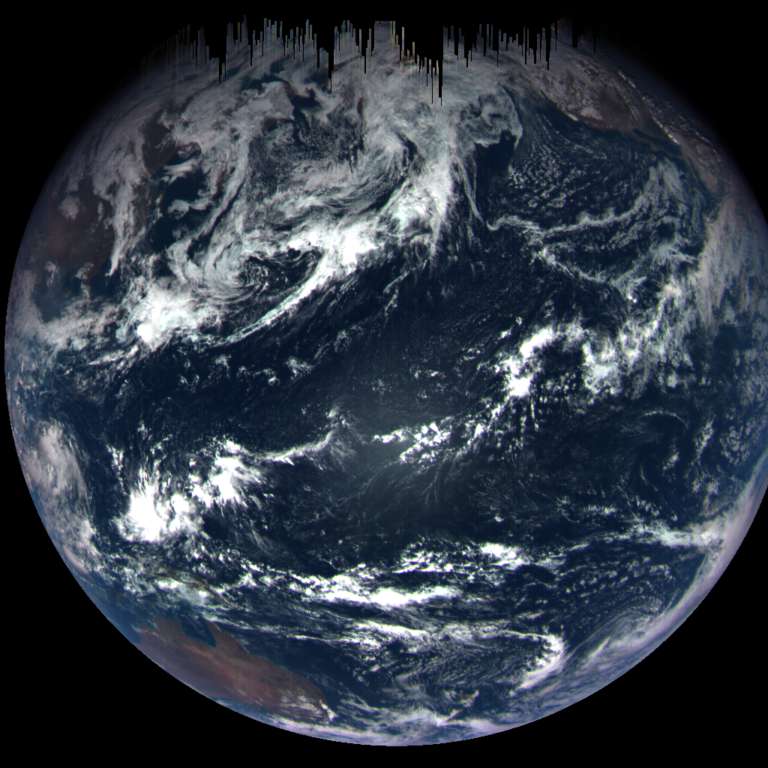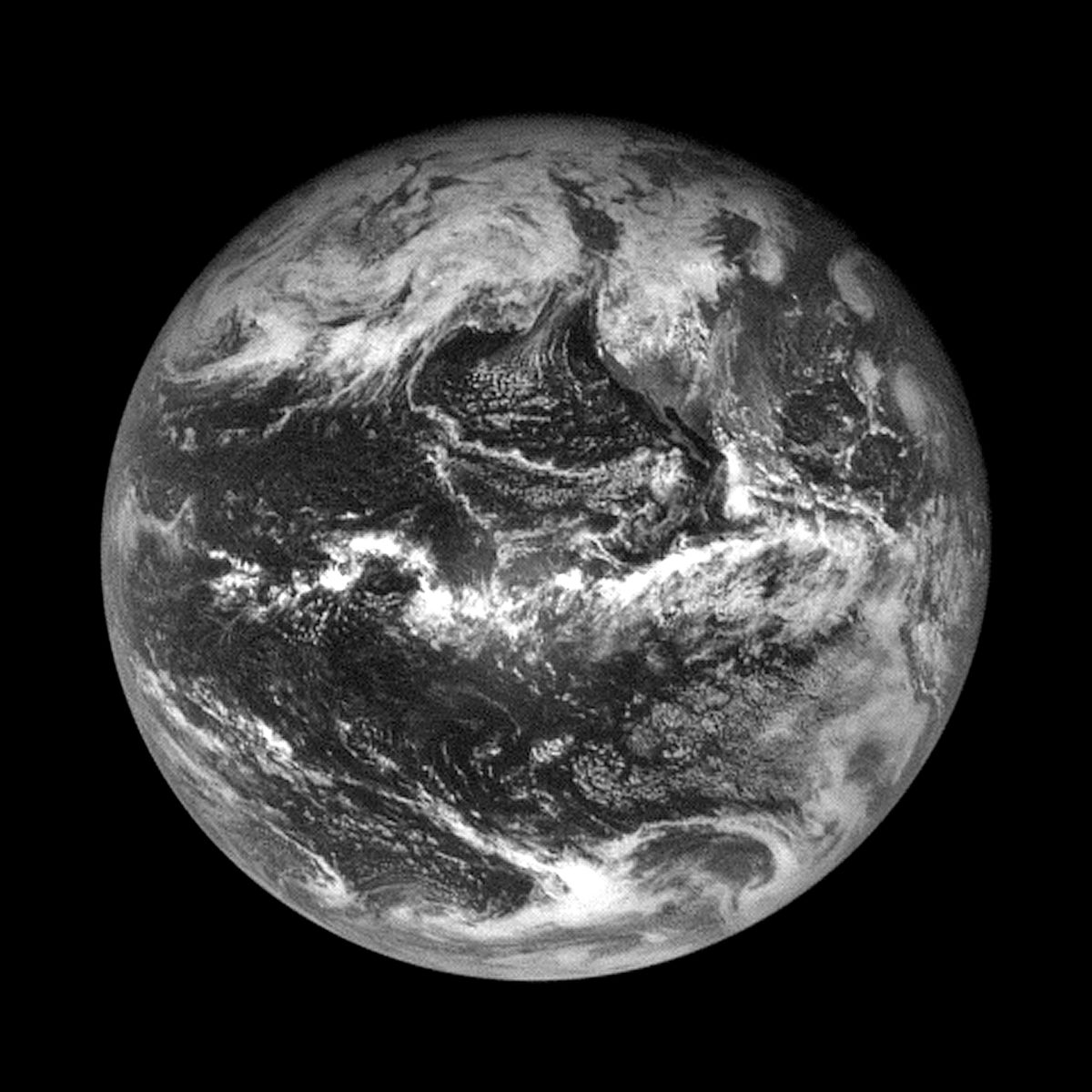Emily Lakdawalla • Sep 28, 2017
Earth flyby tests OSIRIS-REx's cameras
As expected, OSIRIS-REx's Earth flyby on September 22 was a success. The spacecraft coasted past Antarctica at 16:52 UT, using Earth's gravity to bend the spacecraft's trajectory onto a course toward Bennu's tilted orbit. It hit its target within 6 kilometers and 1 second, principal investigator Dante Lauretta says. The next time OSIRIS-REx returns to Earth, on September 24, 2023, it will be carrying samples of asteroid material.

Most of OSIRIS-REx's science instruments turned on after the flyby in order to train themselves on the receding Earth-Moon system. The observation sequences were very similar to what the spacecraft will do during proximity ops at Bennu. The main difference was camera exposure time: Bennu has a very low albedo, so exposure times for brighter Earth had to be set very short. In addition to instrument checkout, the flyby also gave the team operational practice. They are geographically distributed in multiple locations, so this was the first time to see how everything flowed together. Everything flowed great, and the result is some lovely images of our home worlds.

Deputy principal investigator Heather Enos said all data was received as expected. It's not at all uncommon for at least one instrument to go into safe mode during early operational activities like Earth flybys, so OSIRIS-REx's success bodes well for the robustness of the mission. Other early data, from OSIRIS-REX's hunt for Trojan asteroids accompanying Earth in its orbit, revealed that the performance of its highest-resolution PolyCam was better than expected. The better performance means they can begin attempting to spot Bennu as early as July, although they may not spot it until August.

Expect more Earth flyby images to be released every dew days. Sadly, the mission has no plans to release raw image data as past missions have done. However, Enos said they do plan on relatively rapid data release to the Planetary Data System, with quarterly deliveries of data from the period 3 to 6 months prior.
Since the Earth flyby there have been three five-hour periods of science observations, one just a few hours after closest approach, one on September 24 from a range of about 1.2 million kilometers, one yesterday from 3 million kilometers. One more, on October 1, will be at a range of 5 million kilometers. Why wait until they're so far away?
Remember what OSIRIS-REx was designed to do. It's supposed to map and then approach very closely to a very small object. Bennu's size is estimated at about 500 meters. The Moon is 7000 times larger than that, and Earth 26000 times larger. So take the distances OSIRIS-REx travels from Earth and the Moon before testing out its instruments, and divide them by 10000, and you get an idea of how Bennu might appear to OSIRIS-REx from different reasonable ranges. The four post-flyby observation periods at ranges of 100,000, a million, 3 million, and 5 million kilometers are like observing Bennu from ranges of 10, 100, 300, and 500 kilometers. (Remember this when you wonder why all of OSIRIS-REx's approach images of Bennu just look pointlike. Bennu is small.)
OSIRIS-REx has a lot of cameras. In anticipation of more pictures being released, here is a brief summary of their capabilities:
- OCAMS is a suite of three science cameras: PolyCam, MapCam, and SamCam. All share a common detector design, 1024 pixels square. (Read more here.)
- PolyCam has highest resolution (0.0139 mrad pixel scale) and narrowest field of view (0.8 degrees). It will be first to spot Bennu. It is focusable from a range of 200 meters to infinity. It is black-and-white. Bennu will become more than a pointlike object to PolyCam at a distance of about 37,000 kilometers.
- MapCam is intermediate in resolution (0.068 mrad) and field of view (4 degrees). It can take panchromatic (black-and-white) images and also has a filter wheel with 4 color filters with blue, green, and near-infrared wavelengths, so it can produce approximately natural color images. MapCam images of Earth show continents red where you would expect green because chlorophyll is highly reflective in the near-infrared. MapCam is usually in focus from 125 meters to infinity, but one of MapCam's filter positions has a panchromatic diopter lens that allows it to focus at ranges between 25 and 35 meters (without color capability). Bennu will become more than a pointlike object to MapCam at a distance of about 7500 kilometers.
- SamCam has lowest resolution (0.354 mrad) and widest field of view (20.8 degrees). It will be used to photograph sampling activities. It is in focus from 3 meters to infinity, and has a diopter that allows it to be in focus at 2 meters. Although it has a filter wheel, the filter wheel is more like a dust cover -- it contains three identical panchromatic filters so that a new one can be rotated in place if one gets covered with dust, plus the diopter and two lens caps. Bennu will become more than a pointlike object to PolyCam at a distance of about 1400 kilometers.
- TAGCAMS is a suite of three engineering cameras: two Navcams and a Stowcam. They have the same pixel format (2592 by 1944) and the same wide field of view, 44 by 32 degrees. (Read more here.)
- The Navcams have monochrome sensors and are focused at infinity. They are designed to image the asteroid and background stars down to 4th magnitude for navigation purposes. There are two for redundancy.
- Stowcam has a Bayer color sensor and is very nearsighted, focused at the distance of the sample return capsule from the camera. It is designed to document transfer of the sample to the sample return capsule.
Finally, I'll share some images not taken by OSIRIS-REx, but rather, of OSIRIS-REx. Earth flybys are special in part because we get a brief chance to lay eyes on our precious deep space travelers, even if we can only see them as points of light among the stars. Here are a few such views:
Over the weekend, Jost Jahn, using the ROTAT telescope, was the 1st individual to #SpotTheSpacecraft (green circle): https://t.co/SLhDZL3Y4q pic.twitter.com/M1PPx5Famb
— NASA's OSIRIS-REx (@OSIRISREx) September 19, 2017
The 2nd individual to #SpotTheSpacecraft (circled in green) was David Rankin, who took this image from Utah: https://t.co/bR1uFyi0U0 🔭 pic.twitter.com/GIIM3pJJj8
— NASA's OSIRIS-REx (@OSIRISREx) September 19, 2017
Takaaki Oribe caught this image of yours truly from the Saji Observatory in Japan on Sept. 18: https://t.co/QhrHf1ltCg #SpotTheSpacecraft pic.twitter.com/XFCXPDPDB4
— NASA's OSIRIS-REx (@OSIRISREx) September 21, 2017
On Sept. 20, Mike Read imaged me cruising along with the Spacewatch 0.9-m telescope on Kitt Peak: https://t.co/582fJGNZKl #SpotTheSpacecraft pic.twitter.com/VFp00sRQig
— NASA's OSIRIS-REx (@OSIRISREx) September 22, 2017
#OSIRISREx and NGC134 2017 Sep 22 15:10 UTC #iTelescopeT30 #SpotTheSpacecraft pic.twitter.com/96fkDj8eZp
— 井上毅(いのうえたけし) (@INOUE_Takeshi_) September 22, 2017
#SpotTheSpacecraft New observations of @OSIRISREx appearing brighter & faster in the sky as it approaches the #Earth https://t.co/5tz69x1aX3 pic.twitter.com/x5hpBKVWM4
— Elecnor Deimos (@ElecnorDeimos) September 22, 2017
Jason Davis contributed to this article.
Support our core enterprises
Your support powers our mission to explore worlds, find life, and defend Earth. You make all the difference when you make a gift. Give today!
Donate

 Explore Worlds
Explore Worlds Find Life
Find Life Defend Earth
Defend Earth

